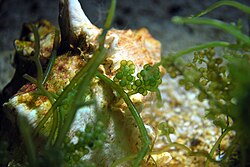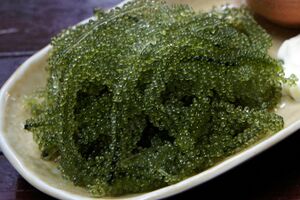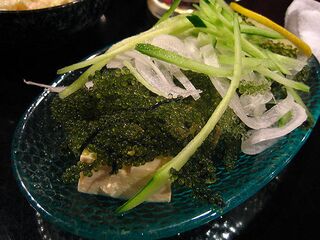Biology:Caulerpa lentillifera
| Caulerpa lentillifera | |
|---|---|

| |
| Caulerpa lentillifera in Chonburi, Thailand | |
| Scientific classification | |
| (unranked): | Viridiplantae |
| Division: | Chlorophyta |
| Class: | Ulvophyceae |
| Order: | Bryopsidales |
| Family: | Caulerpaceae |
| Genus: | Caulerpa |
| Species: | C. lentillifera
|
| Binomial name | |
| Caulerpa lentillifera | |
Caulerpa lentillifera or sea grape is a species of ulvophyte green algae from coastal regions in the Asia-Pacific. This seaweed is one of the favored species of edible Caulerpa due to its soft and succulent texture. It is traditionally eaten in the cuisines of Southeast Asia, Oceania, and East Asia. It was first commercially cultivated in the Philippines in the 1950s, followed by Japan in 1968. Both countries remain the top consumers of C. lentillifera. Its cultivation has since spread to other countries, including Vietnam, Taiwan, and China . C. lentillifera, along with C. racemosa, are also known as sea grapes or green caviar in English.[1]
It is a siphonous macroalgae, meaning it is a giant single cell with multiple nuclei, and can grow to 30 cm in length. Instead of leaves, the algae has bubbles that burst in the mouth, releasing an umami taste.[2]
Commercial cultivation
Traditionally, C. lentillifera were harvested directly from the wild. The first commercial cultivation of C. lentillifera was in the 1950s in Cebu, Philippines , after accidental introduction of C. lentillifera to fish ponds.[3] Currently, there are around 400 hectares of ponds in the Cebu, producing around 12 to 15 tons of fresh C. lentillifera per year. They are usually harvested after two months from first planting, and every two weeks afterwards depending on growth rates.[4]
Commercial cultivation was followed by Japan in 1968, where it was cultivated in tanks in the warmer waters of Okinawa.[5] Commercial cultivation has since spread to other countries, including Vietnam, Taiwan, and China (in Fujian and Hainan). Most are for domestic consumption, but they are also exported to Japan.[6]
Culinary uses

Caulerpa lentillifera, along with C. racemosa, have been traditionally eaten in the cuisines of Southeast Asia, Oceania, and East Asia. They are almost always eaten raw on their own or in salads.[7] They have been described as tasting "like the ocean." It is known to be rich in iodine.[8]
In the Philippines , C. lentillifera is usually known as latô or arosep. After being washed in clean water, it is usually eaten raw as a salad (ensaladang lato), mixed with chopped raw shallots and fresh tomatoes, and dressed with a blend of fish sauce or bagoong (fish paste) and vinegar. Its popularity has also spread to the Malaysian state of Sabah (where it is spelled latok) due to the migrations of the Bajau peoples.[9][4] They are also coveted by coastal Malay communities (as latoh) in the Riau Archipelago and Singapore, the latter until they were displaced inland late 20th century.[10]
In Okinawa, Japan , it is known as umi-budō (海ぶどう), meaning "sea grapes", or kubiretsuta.[11] It is served dipped in ponzu, made into sushi, added into salads, or eaten as is.[12][13]
Caulerpa lentillifera is also eaten in Vietnam, where it is known as rong nho or rong nho biển, meaning "grape algae";[14] in Korea, where it is known as bada podo (바다포도), also meaning "sea grapes"; and in Indonesia (particularly Bali), where it is known as bulung.
Gallery
Ensaladang latô from the Philippines , prepared with vinegar, fish sauce, shallots, and tomatoes
Fresh latô sold at a fish market in the Philippines
See also
- Eucheuma (Gusô)
- Gamet
- Nori
- Sea lettuce
- Sea asparagus
References
- ↑ "Sea grapes - green caviar". http://www.authenticworldfood.com/en/ingredients/sea-grapes-green-caviar/.
- ↑ Revealing Tasty Genetic Secrets of "Sea Grapes"
- ↑ Trono, Gavino C. Jr. (December 1988). Manual on Seaweed Culture. ASEAN/UNDP/FAO Regional Small-Scale Coastal Fisheries Development Project. http://www.fao.org/3/ac417e/AC417E00.htm.
- ↑ Jump up to: 4.0 4.1 Dela Cruz, Rita T.. "Lato: Nutritious Grapes from the Sea". Bureau of Agricultural Research, Republic of the Philippines. https://www.bar.gov.ph/index.php/digest-home/digest-archives/769-2015-4th-quarter/5953-lato-nutritious-grapes-from-the-sea.
- ↑ Trono, G.C. Jr.. "Caulerpa lentillifera (PROSEA)". PROSEA (Plant Resources of South East Asia). https://uses.plantnet-project.org/en/Caulerpa_lentillifera_(PROSEA).
- ↑ Chen, Xiaolin; Sun, Yuhao; Liu, Hong; Liu, Song; Qin, Yukun; Li, Pengcheng (2019). "Advances in cultivation, wastewater treatment application, bioactive components of Caulerpa lentillifera and their biotechnological applications.". PeerJ 7: e6118. doi:10.7717/peerj.6118. PMID 30643691.
- ↑ Paul, Nicholas A.; Neveux, Nicolas; Magnusson, Marie; de Nys, Rocky (21 December 2013). "Comparative production and nutritional value of "sea grapes" — the tropical green seaweeds Caulerpa lentillifera and C. racemosa". Journal of Applied Phycology. doi:10.1007/s10811-013-0227-9.
- ↑ Ratana-arporn, Pattama; Chirapar, Anong (2006). "Nutritional Evaluation of Tropical Green Seaweeds Caulerpa lentillifera and Ulva reticulata". Kasetsart Journal - Natural Science 40: 75–83. https://www.researchgate.net/publication/267256016.
- ↑ Wagey, Billy T; Bucol, Abner A (25 February 2014). "A Brief Note of Lato (Caulerpa racemosa) Harvest at Solong-on, Siquijor, Philippines". e-Journal BUDIDAYA PERAIRAN 2 (1). doi:10.35800/bdp.2.1.2014.3793.
- ↑ Khir Johari (Oct–Dec 2021). "The Role of Foraging in Malay Cuisine". BiblioAsia (National Library Board, Singapore) 17 (3): 20–23. https://biblioasia.nlb.gov.sg/vol-17/issue-3/oct-dec-2021/.
- ↑ Dawes, Clinton J. (1998). Marine botany. New York: John Wiley. ISBN 978-0-471-19208-4.
- ↑ "Umibudo Sea Grapes". https://www.japanvisitor.com/japanese-culture/food/umibudo.
- ↑ "All About Umibudo (Sea Grapes) - Where to Buy, Recipe, and More!". https://www.tsunagujapan.com/umibudo/.
- ↑ Jacobs, Ananda (April 22, 2014). "In search of the fruits of Okinawa's oceans". The Japan Times Online. https://www.japantimes.co.jp/life/2014/04/22/food/search-fruits-okinawas-oceans/.
External links
- Lato, the strange sea salad The trade of the Caulerpa lentillifera in Coron, Philippines
- Guiry, M.D. & Guiry, G.M. 2013. Caulerpa lentillifera J.Agardh, AlgaeBase. National University of Ireland, Galway., accessed 19 February 2013.
- Caulerpa lentillifera, Seaweed Industry Association
Wikidata ☰ Q1936864 entry
 |




